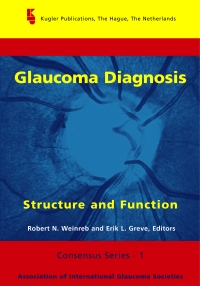1st Consensus Meeting: Glaucoma Diagnosis and Function
San Diego, CA, November 13-14, 2003
edited by Robert N. Weinreb and Erik L. Greve
2004. viii and 152 pages with 17 figures, of which 12 in full color, and one table. Hardbound.
ISBN-10: 90 6299 200 5.
ISBN-13: 978-90-6299-200-3
Published by Kugler Publications.
Click here for more information on all publications in the Consensus series.
Download your free copy of Consensus 1 through the IGR website
Consensus Statements
Structure
- A method for detecting abnormality and also documenting optic nerve structure should be part of routine clinical management of glaucoma.
Explantion: It is known that documentation of optic nerve structure is often
missing in routine ophthalmology practice. - According to limited evidence available sensitivity and specificity of imaging instruments for detection of glaucoma are comparable to that of expert interpretation of stereo colour-photography and should be considered when such expert advice is not available.
Explantion: Experts evaluating stereophotographs are those who have had specialized training and experience in this technique. - Digital imaging is recommended as a clinical tool to enhance and facilitate the assessment of the optic disc and retinal nerve fibre layer in the management of glaucoma.
Explantion: Digital imaging is available for scanning laser tomography, scanning laser polarimetry and optical coherence tomography. Digital imaging also is possible for photography, but assessment remains largely subjective. - Automated analysis of results using appropriate databases is helpful for identifying abnormalities consistent with glaucoma.
Explantion: The comparison of results of examination of individual patients with those of an appropriate database can delineate the likelihood of abnormality. Structural assessment should preferably include such a biostatistical analysis. - Different imaging technologies may be complementary, and detect different abnormal features in the same patients.
Note 1: At this time, evidence does not preferentially support any one of the above structural tests for diagnosing glaucoma
Function
- A method for detecting abnormality and documenting functional status should be part of routine clinical management of glaucoma.
- It is unlikely that one functional test assesses the whole dynamic range.
- Standard Automated Perimetry (SAP), as usually employed in clinical practice, is not optimal for early detection.
- With an appropriate normative database, there is emerging evidence that short wavelength automated perimetry (SWAP) and possibly also frequency doubling technology perimetry (FDT) may accurately detect glaucoma earlier than SAP.
Explantion: Earlier detection of glaucomatous damage with SWAP and FDT than with SAP has been consistently demonstrated. - There is little evidence to support the use of a particular selective visual function test over another in clinical practice because there are few studies with adequate comparisons.Explantion: At this time, there is no evidence to support the superiority of either SWAP vs. FDT.
Function & Structure
- Published literature often lags behind the introduction of new technology. Therefore literature based on previous versions of current technology should be viewed with caution.
- In different cases, either structural examination or functional testing may provide more definitive evidence of glaucoma, so both are needed for detection and confirmation of the subtle early stages of the disease.
Note 2: Data from both functional and structural examinations always should be evaluated in relation to all other clinical data


